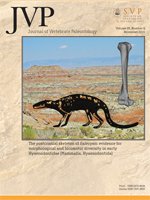A collection of Adjidaumo minimus (Matthew, 1903) from the middle Chadronian (late Eocene) of Natrona County, Wyoming, consists of approximately 150 specimens, the largest sample of Adjidaumo from anywhere. The sample includes several partial to nearly complete crania, the most complete cranial material known for the genus. This large sample of a single species allows an examination of the variability in dental and cranial morphology of the species and a more complete description of the skull. The general morphology of the cranium is similar to that of other eomyids and differs most markedly in having a relatively shorter rostrum, an opening for the sphenopalatine vacuity, and a distinct groove on the alisphenoid. Additional topotypic specimens of A. burkei (Russell, 1954) show that it is a distinct species, rather than a synonym of A. minimus as some authors have suggested. Based on age profiles, the population of Adjidaumo from Jenny's Pocket appears to have been attritionally accumulated, whereas that from Al's Pocket was more likely catastrophic. Although the specimens from Jenny's Pocket were preserved in the filling of a burrow along with bones of a mammalian carnivore, examination of the bones and teeth preserved along with modification of the Adjidaumo skulls and jaws from that site indicate that they were more likely the result of predatory activity of a small owl.
How to translate text using browser tools
1 November 2015
Systematics, Cranial Morphology, and Taphonomy of the Eomyid Rodent Adjidaumo minimus (Matthew, 1903) from the Chadronian (Late Eocene), Flagstaff Rim Area, Wyoming
William W. Korth,
Robert J. Emry,
Marissa R. Musso
ACCESS THE FULL ARTICLE





